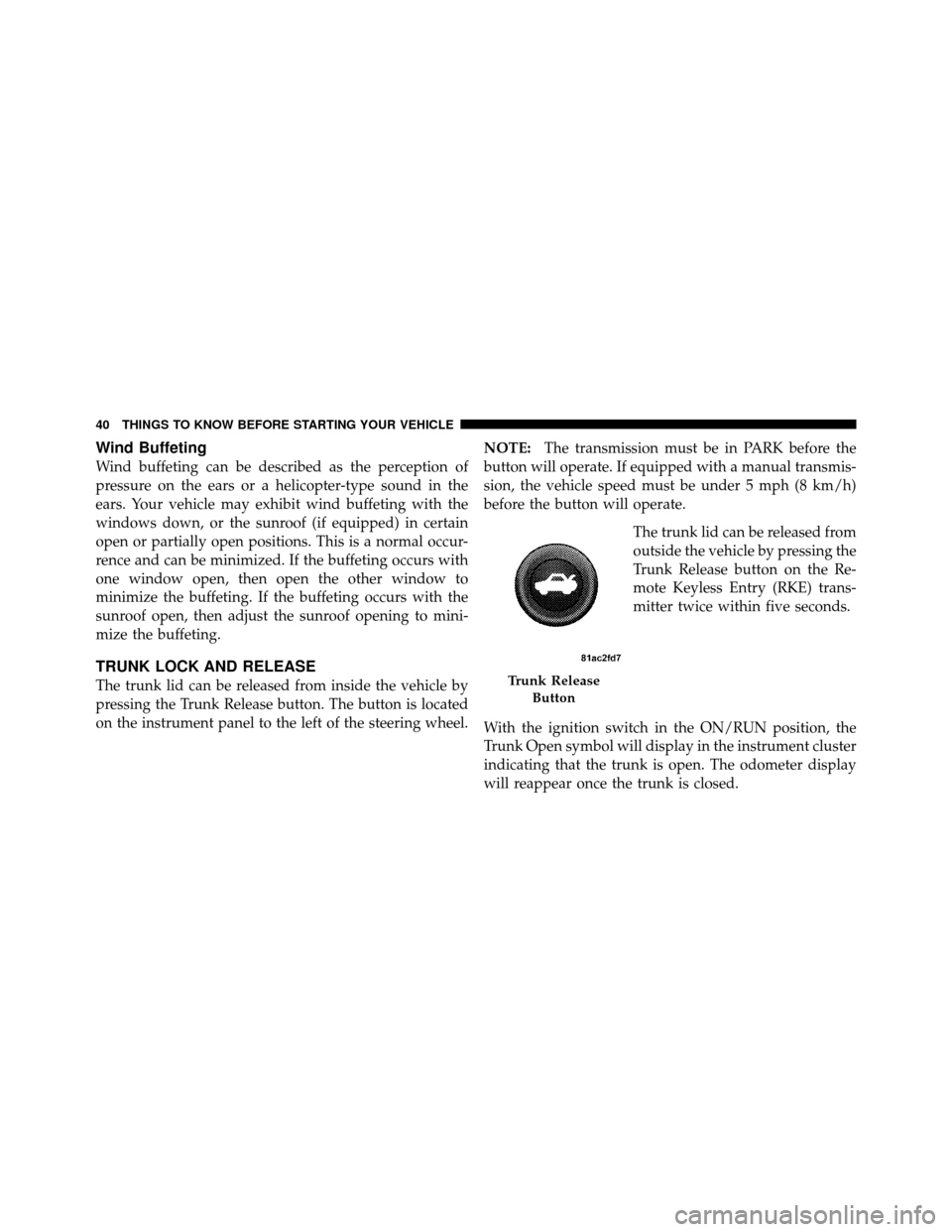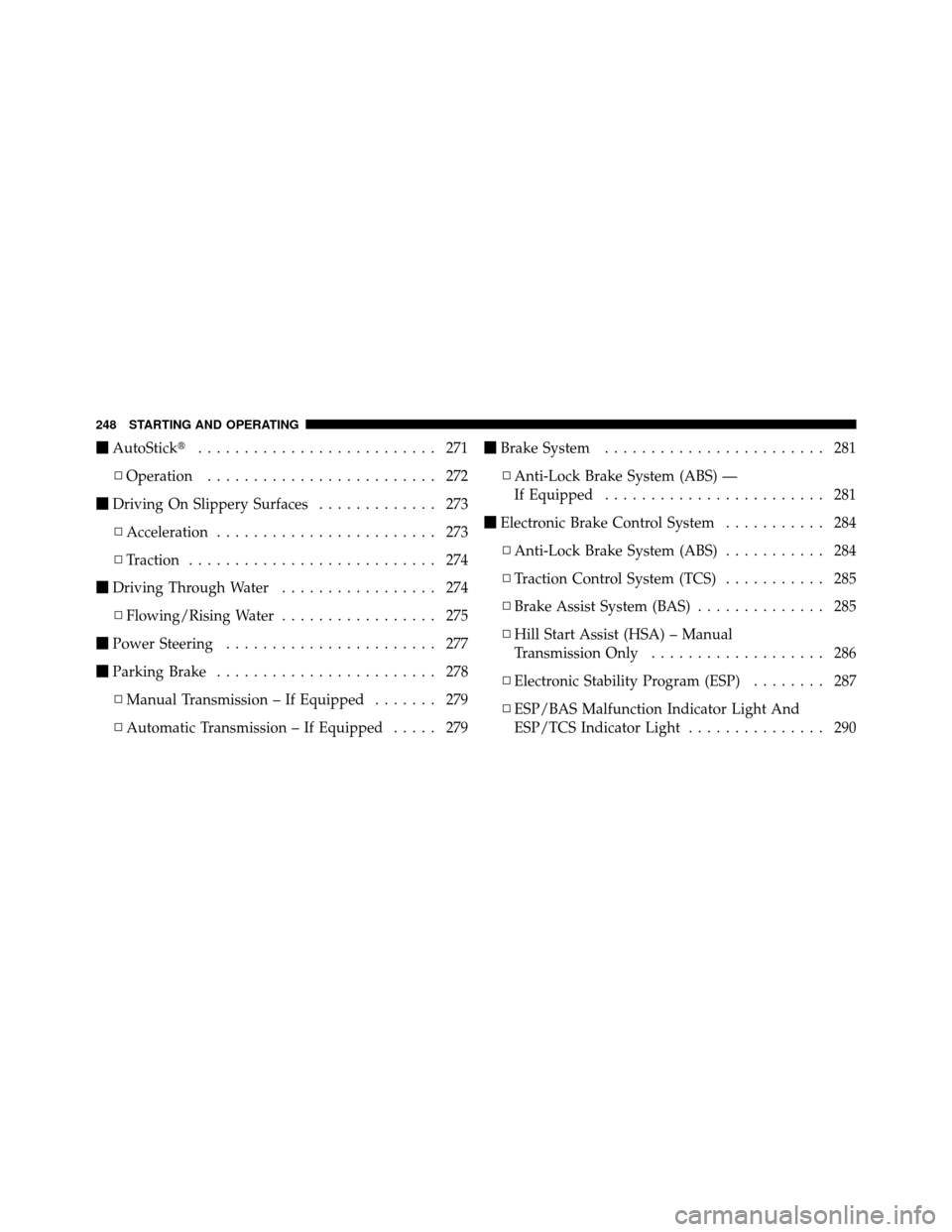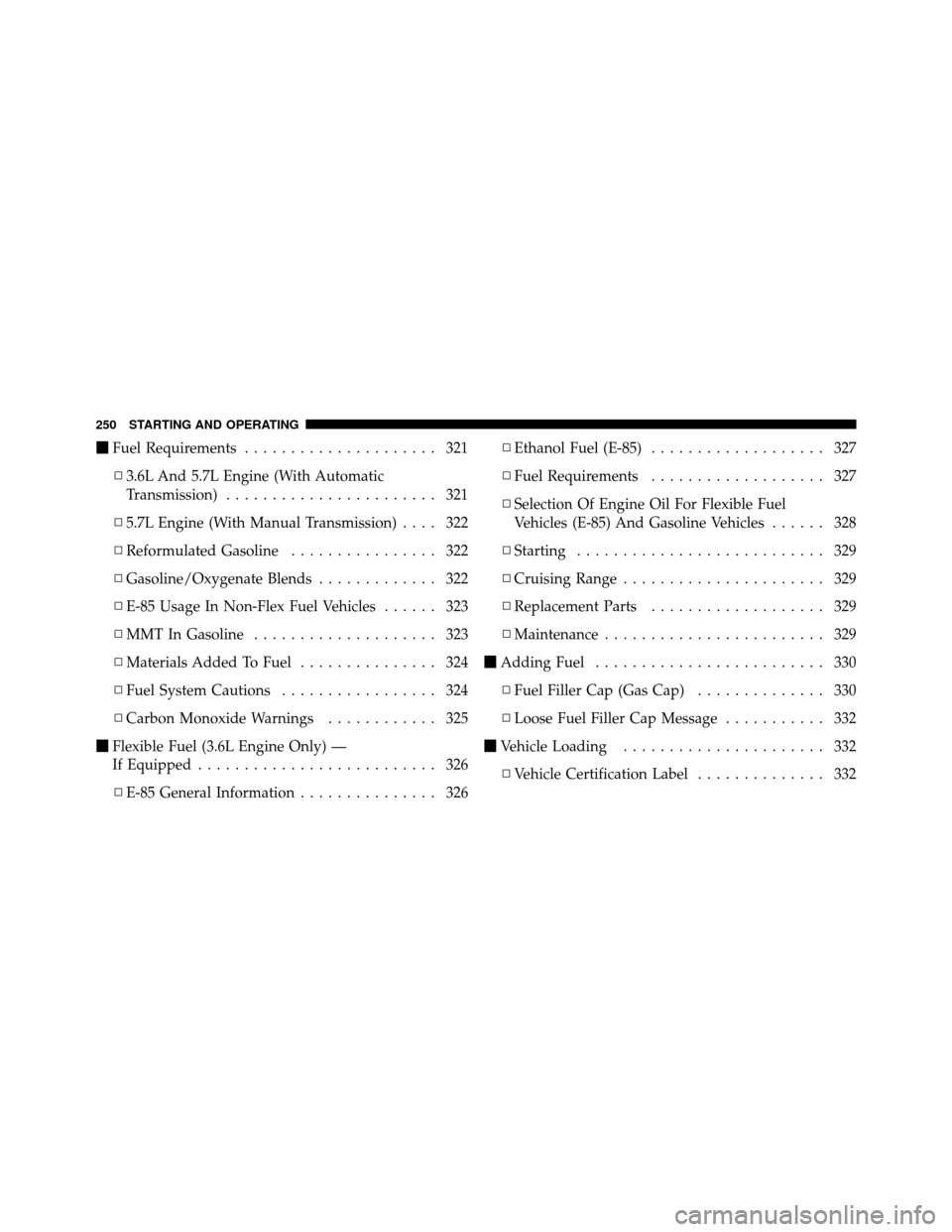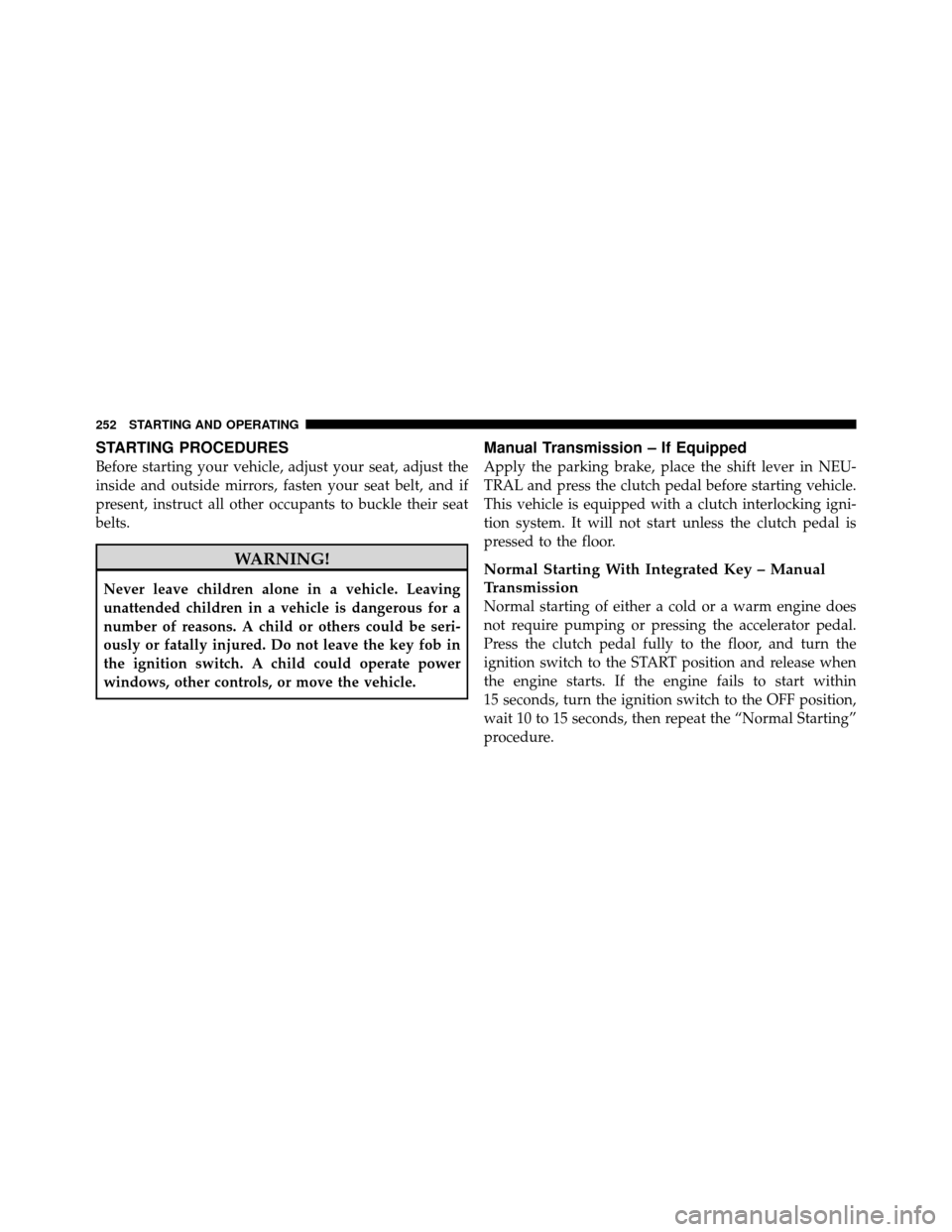Page 42 of 490

Wind Buffeting
Wind buffeting can be described as the perception of
pressure on the ears or a helicopter-type sound in the
ears. Your vehicle may exhibit wind buffeting with the
windows down, or the sunroof (if equipped) in certain
open or partially open positions. This is a normal occur-
rence and can be minimized. If the buffeting occurs with
one window open, then open the other window to
minimize the buffeting. If the buffeting occurs with the
sunroof open, then adjust the sunroof opening to mini-
mize the buffeting.
TRUNK LOCK AND RELEASE
The trunk lid can be released from inside the vehicle by
pressing the Trunk Release button. The button is located
on the instrument panel to the left of the steering wheel.NOTE:
The transmission must be in PARK before the
button will operate. If equipped with a manual transmis-
sion, the vehicle speed must be under 5 mph (8 km/h)
before the button will operate.
The trunk lid can be released from
outside the vehicle by pressing the
Trunk Release button on the Re-
mote Keyless Entry (RKE) trans-
mitter twice within five seconds.
With the ignition switch in the ON/RUN position, the
Trunk Open symbol will display in the instrument cluster
indicating that the trunk is open. The odometer display
will reappear once the trunk is closed.Trunk Release Button
40 THINGS TO KNOW BEFORE STARTING YOUR VEHICLE
Page 249 of 490
STARTING AND OPERATING
CONTENTS
�Starting Procedures .................... 252
▫ Manual Transmission – If Equipped ....... 252
▫ Automatic Transmission – If Equipped ..... 253
▫ Keyless Enter-N-Go – If Equipped ........ 254
▫ Normal Starting ..................... 255
▫ Extreme Cold Weather
(Below –20°F Or �29°C)............... 257
▫ If Engine Fails To Start ................ 258
▫ After Starting ....................... 259 �
Engine Block Heater — If Equipped ........ 259
� Manual Transmission — If Equipped ........ 260
▫ Six-Speed Manual Transmission .......... 260
� Automatic Transmission — If Equipped ...... 264
▫ General Information .................. 265
▫ Key Ignition Park Interlock ............. 267
▫ Brake/Transmission Shift Interlock System . . 267
▫ Five-Speed Automatic Transmission ....... 268
▫ Gear Ranges ........................ 268
5
Page 250 of 490

�AutoStick� .......................... 271
▫ Operation ......................... 272
� Driving On Slippery Surfaces ............. 273
▫ Acceleration ........................ 273
▫ Traction ........................... 274
� Driving Through Water ................. 274
▫ Flowing/Rising Water ................. 275
� Power Steering ....................... 277
� Parking Brake ........................ 278
▫ Manual Transmission – If Equipped ....... 279
▫ Automatic Transmission – If Equipped ..... 279�
Brake System ........................ 281
▫ Anti-Lock Brake System (ABS) —
If Equipped ........................ 281
� Electronic Brake Control System ........... 284
▫ Anti-Lock Brake System (ABS) ........... 284
▫ Traction Control System (TCS) ........... 285
▫ Brake Assist System (BAS) .............. 285
▫ Hill Start Assist (HSA) – Manual
Transmission Only ................... 286
▫ Electronic Stability Program (ESP) ........ 287
▫ ESP/BAS Malfunction Indicator Light And
ESP/TCS Indicator Light ............... 290
248 STARTING AND OPERATING
Page 252 of 490

�Fuel Requirements ..................... 321
▫ 3.6L And 5.7L Engine (With Automatic
Transmission) ....................... 321
▫ 5.7L Engine (With Manual Transmission) .... 322
▫ Reformulated Gasoline ................ 322
▫ Gasoline/Oxygenate Blends ............. 322
▫ E-85 Usage In Non-Flex Fuel Vehicles ...... 323
▫ MMT In Gasoline .................... 323
▫ Materials Added To Fuel ............... 324
▫ Fuel System Cautions ................. 324
▫ Carbon Monoxide Warnings ............ 325
� Flexible Fuel (3.6L Engine Only) —
If Equipped .......................... 326
▫ E-85 General Information ............... 326 ▫
Ethanol Fuel (E-85) ................... 327
▫ Fuel Requirements ................... 327
▫ Selection Of Engine Oil For Flexible Fuel
Vehicles (E-85) And Gasoline Vehicles ...... 328
▫ Starting ........................... 329
▫ Cruising Range ...................... 329
▫ Replacement Parts ................... 329
▫ Maintenance ........................ 329
� Adding Fuel ......................... 330
▫ Fuel Filler Cap (Gas Cap) .............. 330
▫ Loose Fuel Filler Cap Message ........... 332
� Vehicle Loading ...................... 332
▫ Vehicle Certification Label .............. 332
250 STARTING AND OPERATING
Page 253 of 490
▫Gross Vehicle Weight Rating (GVWR) ...... 333
▫ Gross Axle Weight Rating (GAWR) ........ 333
▫ Overloading ........................ 333
▫ Loading ........................... 334
� Trailer Towing ........................ 334
▫ Common Towing Definitions ............ 335
▫ Trailer Hitch Classification .............. 337
▫ Trailer Towing Weights
(Maximum Trailer Weight Ratings) ........ 338▫
Trailer And Tongue Weight ............. 338
▫ Towing Requirements ................. 339
▫ Towing Tips ........................ 344
� Recreational Towing
(Behind Motorhome, Etc.) ................ 346
▫ Towing This Vehicle Behind Another Vehicle
— Automatic Transmission ............. 346
▫ Towing This Vehicle Behind Another Vehicle
— Manual Transmission ............... 346
5
STARTING AND OPERATING 251
Page 254 of 490

STARTING PROCEDURES
Before starting your vehicle, adjust your seat, adjust the
inside and outside mirrors, fasten your seat belt, and if
present, instruct all other occupants to buckle their seat
belts.
WARNING!
Never leave children alone in a vehicle. Leaving
unattended children in a vehicle is dangerous for a
number of reasons. A child or others could be seri-
ously or fatally injured. Do not leave the key fob in
the ignition switch. A child could operate power
windows, other controls, or move the vehicle.
Manual Transmission – If Equipped
Apply the parking brake, place the shift lever in NEU-
TRAL and press the clutch pedal before starting vehicle.
This vehicle is equipped with a clutch interlocking igni-
tion system. It will not start unless the clutch pedal is
pressed to the floor.
Normal Starting With Integrated Key – Manual
Transmission
Normal starting of either a cold or a warm engine does
not require pumping or pressing the accelerator pedal.
Press the clutch pedal fully to the floor, and turn the
ignition switch to the START position and release when
the engine starts. If the engine fails to start within
15 seconds, turn the ignition switch to the OFF position,
wait 10 to 15 seconds, then repeat the “Normal Starting”
procedure.
252 STARTING AND OPERATING
Page 257 of 490

NOTE:The ENGINE START/STOP button should only
be removed or inserted with the ignition in the OFF
position.
Normal Starting
Using The ENGINE START/STOP Button –
Automatic Transmission Only
NOTE: Normal starting of either a cold or a warm
engine is obtained without pumping or pressing the
accelerator pedal.
To start the engine, the transmission must be in PARK or
NEUTRAL. Press and hold the brake pedal while press-
ing the ENGINE START/STOP button once. The system
takes over and attempts to start the vehicle. If the vehicle
fails to start, the starter will disengage automatically after
10 seconds. If you wish to stop the cranking of the engine
prior to the engine starting, press the button again.
Using The ENGINE START/STOP Button –
Manual Transmission Only
NOTE: Normal starting of either a cold or a warm
engine is obtained without pumping or pressing the
accelerator pedal.
To start the engine, press and hold the clutch pedal while
pressing and holding the ENGINE START/STOP button.
Release the button when the engine starts. If the vehicle
fails to start within 15 seconds, release the button, wait 10
to 15 seconds, then repeat the “Normal Starting” proce-
dure. If you wish to stop the cranking of the engine prior
to the engine starting, release the button.
To Turn Off The Engine Using ENGINE
START/STOP Button – Automatic Transmission
Only
1. Place the shift lever in PARK, then press and release
the ENGINE START/STOP button.
5
STARTING AND OPERATING 255
Page 258 of 490

2. The ignition switch will return to the OFF position.
3. If the shift lever is not in PARK, the ENGINE START/
STOP button must be held for two seconds and vehicle
speed must be above 5 mph (8 km/h) before the engine
will shut off. The ignition switch position will remain in
the ACC position until the shift lever is in PARK and the
button is pressed twice to the OFF position. If the shift
lever is not in PARK and the ENGINE START/STOP
button is pressed once, the EVIC (if equipped) will
display a “VEHICLE NOT IN PARK” message and the
engine will remain running. Never leave a vehicle out of
the PARK position, or it could roll.
NOTE:If the ignition switch is left in the ACC or RUN
(engine not running) position and the transmission is in
PARK, the system will automatically time out after
30 minutes of inactivity and the ignition will switch to the
OFF position.To Turn Off The Engine Using ENGINE
START/STOP Button – Manual Transmission Only
1. With the vehicle stopped, place the shift lever in
NEUTRAL, then press and release the ENGINE START/
STOP button.
2. The ignition switch will return to the OFF position.
3. Place the shift lever in first gear or Reverse and then
apply the parking brake.
NOTE:
•If the ignition switch is left in the ACC position, the
system will automatically time out after 30 minutes of
inactivity and the ignition will switch to the OFF
position.
•If the ignition switch is left in the RUN position, the
system will automatically time out after 30 minutes of
inactivity if the vehicle speed is 0 mph (0 km/h) and
the engine is not running.
256 STARTING AND OPERATING